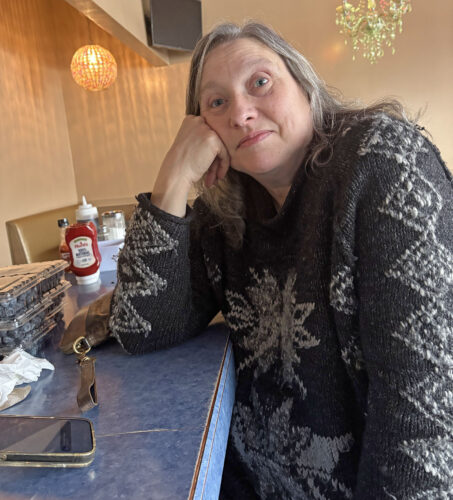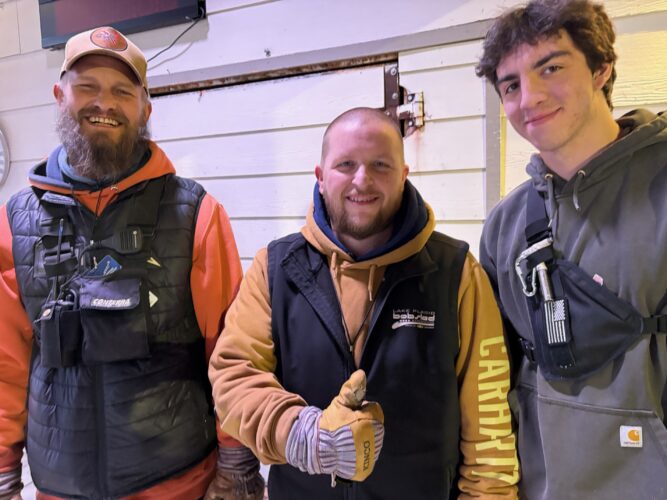ON THE SCENE: Reading ‘Six Men Dressed Like Joseph Stalin’
- Playwright Diane Nora and Gabrielle Schutz, artistic director of the Recovery Lounge (Provided photo — Naj Wikoff)
- In costume during a reading of the play “Six Men Dressed Like Joseph Stalin” Saturday, Nov. 18 at the Recovery Lounge in Upper Jay are actors Tyler Nye, left, and Noel Carmichael. (Provided photo — Naj Wikoff)

In costume during a reading of the play “Six Men Dressed Like Joseph Stalin” Saturday, Nov. 18 at the Recovery Lounge in Upper Jay are actors Tyler Nye, left, and Noel Carmichael. (Provided photo — Naj Wikoff)
A challenge of being Joseph Stalin, the all-powerful dictator leading the Soviet Union, was many people would try to kill you, even if it meant losing their own life. After taking power in 1924 following the death of Vladimir Lenin, Stalin became one of the world’s worst mass murderers, responsible for the death of tens of millions of his countrymen through execution, famine, forced labor and mass murder by the time he died in 1953.
Knowing that Stalin’s life was at risk when he was out in public, his security chief Nikolay Vlasik sought out men who could stand in for him, whose appearance was so similar to Stalin’s that they, wearing his trademark outfits, could be his double. One of his doubles, Feliks Dadaev, said in 1996 that there had been three others. Underscoring the danger to Stalin and to the doubles, the first, the Caucasian Rashidov, lost his life to a roadside bomb while riding in a car into Red Square.
Coming across Dadaev’s story of being one of several doubles inspired playwright Dianne Nora to create a play about the recruiting and training of a double and the emotional challenges for both the double and his trainer as they considered the potential outcomes of succeeding or failing in their endeavor. Titled “Six Men Dressed Like Joseph Stalin,” a reading of the play, still in development, was held at the Recovery Lounge (Upper Jay Art Center) on Saturday evening, Nov. 18.
Nora — a playwright, dramaturg and comedy writer — was commissioned to write the play “Ruth Bader Ginsburg: A Living Document” during 2018-19 while a member of the Goodman Theatre’s Playwright Unit. She assisted playwright Tracy Letts on the Broadway productions and world premiere of his play, “The Minutes,” a finalist for the 2018 Pulitzer Prize in drama. The following year, Nora took an abbreviated version of her play, “Monica: This Play Is Not About Monica Lewinsky,” to Edinburgh where The Spectator named it “Best of the Fringe.”
Fortunately for North Country residents, the Recovery Lounge’s artistic director, Gabrielle Schutz, has long known Nora. While looking for a play to use for a reading, she reached out to see if Nora had anything in the works that might be available.

Playwright Diane Nora and Gabrielle Schutz, artistic director of the Recovery Lounge (Provided photo — Naj Wikoff)
“Diane and I met many years ago in the city and worked together a little bit,” said Schutz. “I was very excited seeing her new works popping up and circulating. I was eager to see if we could bring some of it here, and today we are.”
Schutz told the audience that Nora had a table of index cards, each with a different question, in the back of the room that she hoped members of the audience would be willing to fill out as she desired their feedback. She said picking the audience’s brains is valuable for playwrights developing new work.
Schutz provided stage direction, and Noel Carmichael and Tyler Nye read the play, which lasted about 90 minutes. In her introductory remarks, Schutz said that any two actors could read the part, what they both had to do was wear a large mustache, a feature that Stalin was known for. She started by reading a quote by Vyacheslav Mikhaylovich Molotov: “He was a different man at different times.”
“I had started reading about propaganda in the Soviet Union and found it interesting,” said Nora. “At the same time, I was studying Isaac Butler’s great book, ‘The Method: How the Twentieth Century Learned to Act,’ the history of presentational acting that led to the Stanislavski system. I was amazed by how many of these early actors had lost their lives because of everything that was happening politically. Theater mattered, and I fell down a rabbit hole.”
The outcome was her writing “Six Men Dressed Like Joseph Stalin.” The play opens with Soso, who had been left for dead on the Eastern Front. Found to have a shocking resemblance to Stalin, Soso is brought to the Kremlin. There, Koba is tasked with training him to take on the role of a lifetime, stepping in as Stalin’s double, to become Stalin in his thinking, manner, and actions, and the challenges that Soso’s role poses for them both.
“All the nuggets in this play, the names and places, are real,” said Nora. “All the references that these characters are based on are real.”
The dialogue was not real; all that Nora imagined. She based the characters’ dialogue on her readings and knowledge of the history of the Method, which requires understanding and experiencing a character’s inner motivation and emotions. The Method was developed by Russian theater practitioner Konstantin Stanislavski, who co-founded the Moscow Art Theatre in the 1890s and was influenced by the teachings of the playwright Anton Chekhov. This link was illustrated in the play by Soso and Koba referencing and quoting from Chekhov’s play The Seagull.
“I do like taking historical figures and playing with that history,” said Nora. “Much of our history is filtered through propaganda, so we don’t know if it is accurate. We don’t know if the character Soso is based on lived or died, if he is still alive, he’d be over a hundred now. Feliks Dadaev, who was a double, wrote about it, but as we can’t access his writings, I find it a fun place for exploration. I wanted to create something like the stories they would tell if they ever had that opportunity.”
“I love working on plays that are in development,” said Carmichael, who played Koba. “With any play, you want to dig into it and ask about it. With this play, we had the playwright sitting here. We can ask why they made that choice or suggest they cut that line; the process is very alive.”
“It was amazing to have the playwright in the room,” said Nye, who played Soso. “You seldom get that opportunity, especially with such an accomplished playwright and with a play that hasn’t been staged. It’s very exciting.”
“I was very impressed,” said audience member Fred Balzac. “It seemed pretty done to me. I love how Diane marries the history, which I am unfamiliar with, with whatever she made up. For the playwright, seeing it performed on stage by actors is very important up to that point, its words on a page.”
(Naj Wikoff lives in Keene Valley. He has been covering events for the Lake Placid News for more than 15 years.)



